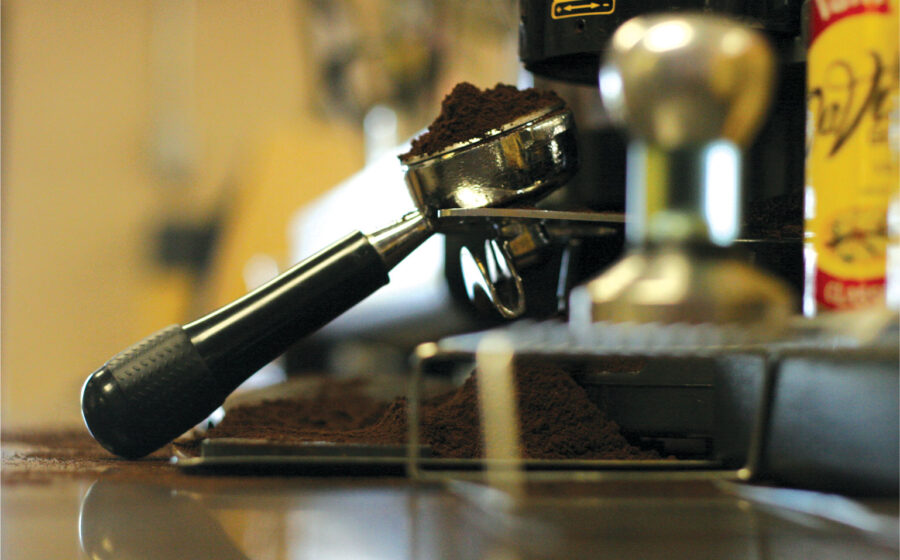[O]n the side of nearly every bag of retail coffee available for sale in the United States, there is a statement that looks something like this: “We recommend using two tablespoons of freshly ground coffee for every six ounces of water.” It’s an island of consistency in packaging, which rarely shares any similarities beyond the word coffee.
That’s because when it comes to the outlines of brewing coffee or espresso there is general agreement within the industry, but then a gulf breaks and grows as you zoom into the specifics of the process. For instance, we all agree that the grind should be fairly fine for espresso. More specific than that, and we start to disagree with each other, albeit slightly. We also agree that you should dose and tamp the coffee consistently, but what that looks like in practice includes a broad spectrum of habits and processes.
Just as the grind setting affects the extraction and flavor of the final espresso, the amount of coffee used for each shot does as well. A difference of a gram of coffee can have dramatic results in the liquid inhabiting the tiny demitasse.
Let’s start then with a general truth, and move carefully into specifics from there: you should dose your espresso consistently. A consistent dose of coffee coupled with an accurate grind will get you most of the way to a great shot of espresso. There are a number of ways to get to that consistent dose, depending on the equipment you have and the time you’re willing to devote to it.
First, you can rely on the basket in your portafilter to measure your dose. Only so much coffee can fit in it, and it’s generally true that if you fill it up with ground coffee, level it, and tamp it, you’ll get some modicum of consistency. But any changes to the coarseness of the grind, or tapping of the portafilter (which will settle the coffee, leaving room at the top), and your dose will change. Measuring coffee by volume is a start, but there are better ways.
Coffee professionals can agree that you should dose consistently, but we can’t seem to agree on the amount you should put in your portafilter. Like most things, it’s a matter of taste.
Second, you could purchase a grinder that manages your dose with a timer or a scale. These grinders (often confusingly called “doserless”) can go a long way in improving your dose consistency. They work by grinding and dispensing coffee for a set time or a set weight, which the operator programs. There is a wide range of accuracy with these grinders, from less than half a gram variances to well over a gram, which can make a significant difference in how your espresso plays out.
The third way, which can happily sit alongside the first two, is to have a gram scale by your espresso grinders, and periodically weigh your dose. The more often you weigh it, the more labor intensive each beverage becomes, but your consistency is also better. Weighing every shot becomes difficult—if not impossible—in a busy café where speed of service is a priority. A scale can be an invaluable tool, though, when you pair it with a grinder that doses fairly consistently.
How much do you dose, though? How much coffee is the “right” amount for a double espresso? That’s easy! Somewhere between fourteen and twenty-five grams. D’oh!
Coffee professionals can agree that you should dose consistently, but we can’t seem to agree on the amount you should put in your portafilter. Like most things, it’s a matter of taste. A fourteen-gram double espresso and one with almost twice that much coffee will taste quite different. The grind necessary for such dissimilar doses will be different as well.
Is a heavy or light dose better? Every coffee is different, so there’s no way to say. As an example, I took a Papua New Guinea AA and dialed it in with two different doses: fourteen and twenty–three grams. The fourteen-gram espresso had a simpler, more open flavor, with notes of cocoa that dominated the cup. The twenty-three gram espresso was much brighter with outstanding berry and citrus characteristics. It was dense and sweet. Neither was better than the other. I would probably have preferred something in between those two doses, but it took tasting both of them to realize that.
The only way to know your preference, then, is to taste your coffee. What a pleasant resolution to our issue! You have a flavor (or flavors) you’re looking for in your espressos, your lattes, and your other drinks. So wide is the range and so broad are the results of the “acceptable” amounts of coffee for an espresso that there is a wonderful opportunity for you as the café owner, manager, or barista to bring your own tastes to the table.
For years the best espresso I’d ever made was with a fifteen-gram dose. It was bright, but it had a wide-open middle full of sweetness, floral and citrus notes, and a big juicy mouthfeel. Since then, I’ve had excellent espressos at nearly every half-gram increment in the range. Making a great espresso with a certain dose of coffee isn’t difficult. Making 100 great espressos without ensuring the dose is consistent might as well be impossible.
—Nathanael May is director of coffee for Portland Roasting.
















